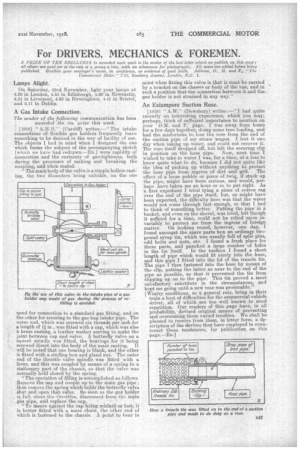For DRIVERS MECHANICS & FOREMEN
Page 21

If you've noticed an error in this article please click here to report it so we can fix it.
A PRIZE OF TEN SHILLINGS is awarded each week to the sender of the best letter which we publish on this page ; all others are paid for at the rate of a penny a lane, with an allowance for photographs. All notes are edited before being published. Mention your employer's name, in confidence, as evidence of good faith. Address, A, M. and F.„" The Commercial Motor," 7-15, Rosebery Avenue, London, B.C. 1.
Lamps Alight.
On Saturday, 23rd November, light your lamps at 4.30 in London, 4.51 in Edinburgh, 4.20 in Newcastle, 4.31 in Liverpool, 4.33 in Birmingham, 4.41 in Bristol, and 5.11 in Dublin.
A Gas Intake Connection.
The sender of the following communication has been awarded the los. prize this week.
[1918] "A.11.11!' (Cardiff) writes :—" The intake connections of flexible gas holders frequently leave something to be desired in the way of facility of use. The objects I had in mind when I designed the one which forms the subject of the accompanying sketch [which we have had redrawn.—En.] were rapidity of connection and the certainty of gas-tightness, botli during the processes of making and breaking the coupling, and when sealed. • "The main body of the valve is a simple hollow casting, the two diameters being suitable, on the one
nand for connection to a standard gas fitting, and on the other for securing to the gas bag intake pipe. The outer end, which was screwed six threads per inch for a length of 1i in., was fitted with a cap, which was also a brass casting, a leather washer serving to make the joint 'between cap and valve. A butterfly valve on a square spindle was fitted, the bearings for it being screwed direct into the body of the main casting. It will be noted that one bearing is blank, and the other is fitted with a stuffing box and gland nut. The outer end of the throttle valve spindle was fitted with a lever, and this was coupled by means of a spring to a stationary part of the chassis, so that the valve was normally held closed by the spring. "The operation of filling is,accomplished as follows. Remove the cap and couple up to the main gas pipe ; then remove the spring which holds the butterfly valve shut and open that valve. So soon as the gas holder is full, close the throttles, disconnect from the main gas pipe, and replace the cap.,
"To insure against the ea,p being mislaid.or lost, it is better fitted with a loose chain, the other end of which is fastened to the chassis. A point to bear in
mind-when fitting this valve is that it mast be carried by a bracket on the chassis or body of the van, and in such a position that tne connection between it and the , gas holder is not strained in any way."
An Extempore Suction Rose.
[19191 " A.W." (Dewsbury) writes :—" I had .quite recently an interesting experience, which you may, perhaps, think of sufficient importance to mention on your ' D.M. and F.' page. I was away from home for a few days together, doing some tree loading, and had the misfortune to lose the rose from the end of the suction pipe of my steam wagon. I lost it one day when taking up water, and could not recover it. The rose itself dropped off, but left the securing clip in position on the .hose pipe. Now, next time / wished to take in water I was, for a time, at a loss to know quite what to do, because I dill not quite like the idea of picking up without anything to protect the hose pipe from ingress of dirt and grit. The effect of a loose pebble or piece of twig, if stuck up the pipe, might have been serious, and would, perhaps have taken me an hour or so to put right. As a first expedient I tried tying a piece of cotton rag over the end of the pipe itself, but, as might have been expected, the difficulty here was that the water would not come through fast enough, so that I had to think of something better. Putting the pipe in a bucket, and even on the shovel, was tried, but though it sufficed for a time, could not be relied upon invariably to protect me from the ingress of foreign matter. On looking round, however, one day, I found amongst the spare parts box an ordinacy twopound syrup tin, which was usually full of split pins, odd bolts and nuts, etc. I found a fresh place for these parts, and punched a large number of holes in the tin itself. In the toolbox I found a short length of pipe which would fit nicely into the hose, and this pipe I fitted into the lid of the treacle tin. The pipe I then fastened into the hose by means of the clip, putting the latter as near to the end of the pipe as possible so that it prevented the tin from slipping up on possible, the pipe. This tin proved a most satisfactory substitute in the circumstances, and kept me going until a new rose was procurable!'
[Wintry conditions, as a general rule, bring in their train a host of difficulties for the commercial-vehicle driver, all of which are too well known to need repetition. Our readers of this page have, in all probability, devised original means of preventing and overcoming these varied troubles. We shall be pleased to receive from them, in letter form, a description of the devices they have employed to counteract these tendencies, for publication on this page.—En.]






















